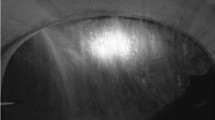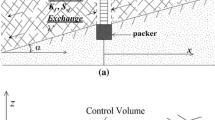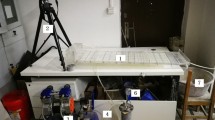Abstract
A laboratory analogue experiment platform with an artificial fracture was built to analyze the effect of slug interference tests on the evaluation of the hydraulic properties of fractured rocks. The response of an aquifer to a slug source well was analyzed using type-curve comparisons under the condition of different radial constant-water-head boundaries. The injecting-water, releasing-water, and pneumatic laboratory experiments of the slug interference tests were conducted in an artificial fracture. The relationship between the critical distance of the radial constant-water-head boundary and the dimensionless storage coefficient approximately followed a power function. The empirical formula provides an intuitive and effective reference criterion for considering the influence of the radial constant-water-head boundaries during field slug interference tests. When the radial constant-water-head boundary distances are less than the critical values, the boundary leads to an obvious increase in the recovery rate during the late response period, and the response peaks of the aquifer shift to an earlier time in the low-storage fractured rocks. The monitoring and analysis of the response in fractured rocks can improve the accuracy of the transmissivity and storage coefficient estimations, particularly when the slug interference tests are affected by the radial constant-water-head boundaries.
Résumé
Une plateforme d’expérimentation analogique en laboratoire dotée d’une fracture artificielle a été construite en vue d’analyser les effets des essais d’interférence de type slug sur l’évaluation des propriétés hydrauliques des roches fracturées. La réponse d’un aquifère à une impulsion dans un puits est analysée à l’aide de comparaison avec des courbes types pour des conditions de différentes limites radiales à charge constante. Les expérimentations d’injection, de relargage d’eau et d’essais pneumatiques des essais d’interférence de type slug ont été réalisées sur une fracture artificielle. La relation entre la distance critique de la la limite radiale à charge constante et le coefficient d’emmagasinement sans unité suit approximativement une fonction puissance. La formule empirique fournit un critère de référence intuitif et efficace pour considérer l’influence des limites radiales à charge constante, durant les essais d’interférence de type slug sur le terrain. Quand les distances à la limite radiale à charge constante sont inférieures aux distances critiques, les limites conduisent à une augmentation visible de la vitesse de remontée durant la fin de la période de réponse, et les pics de réponse de l’aquifère sont plus précoces dans les roches fracturées à faible coefficient d’emmagasinement. Le suivi et l’analyse de la réponse dans les roches fracturées peut améliorer la précision de l’estimation de la transmissivité et du coefficient d’emmagasinement, en particulier quand les essais d’interférence de type slug sont affectés par des limites radiales à charge constante.
Resumen
Se construyó una plataforma experimental analógica de laboratorio con una fractura artificial para analizar el efecto de las interferencias en los slug tests en la evaluación de las propiedades hidráulicas de las rocas fracturadas. Se analizó la respuesta de un acuífero a un pozo slug fuente usando comparaciones de curvas de tipo bajo la condición de diferentes límites radiales con carga hidráulica constante. Los experimentos de inyección de agua, liberación de agua y laboratorio de las interferencias en los slug tests se realizaron en una fractura artificial. La relación entre la distancia crítica del límite radial a carga hidráulica constante y el coeficiente de almacenamiento adimensional siguió aproximadamente una función de potencia. La fórmula empírica proporciona un criterio de referencia intuitivo y eficaz para considerar la influencia de los límites radiales con carga hidráulica constante por la interferencia de los slug test. Cuando las distancias de los límites radiales a carga hidráulica constante son inferiores a los valores críticos, el límite da lugar a un aumento evidente de la tasa de recuperación durante el período de respuesta tardío, y los picos de respuesta del acuífero se desplazan a un momento anterior en las rocas fracturadas de bajo almacenamiento. El monitoreo y el análisis de la respuesta en las rocas fracturadas pueden mejorar la precisión de las estimaciones de la transmisividad y el coeficiente de almacenamiento, en particular cuando las interferencias de los slug test se ven afectadas por los límites radiales a carga hidráulica constante.
摘要
为了分析振荡扰动试验对评价裂隙岩体水力特性的作用, 建造了一个包含人造裂隙的室内模拟实验平台。基于不同径向定水头边界条件下标准曲线的对比, 分析了含水层对振荡主井的响应。在人造裂隙中实施了注水式、抽水式和气压式振荡试验。径向定水头边界影响临界距离与无量纲贮水系数之间存在幂函数关系, 该经验公式为野外实施振荡扰动试验过程中判断是否要考虑径向定水头边界提供了直观有效的参考准则。在低贮水性裂隙岩体中当径向定水头边界距离小于临界值时, 定水头边界会导致试验后期水位恢复速率明显增加, 并且裂隙含水层中水头响应峰值会更早到达。裂隙岩体中水头响应监测和分析可以提高确定裂隙导水系数和贮水系数的准确性, 尤其是振荡扰动试验受到径向定水头边界影响时。
Resumo
Uma plataforma experimental análoga de laboratório contendo uma fratura artificial foi construída para avaliar os efeitos de ensaios de interferência instantânea no comportamento das propriedades hidráulica de rochas fraturadas. A resposta de um aquífero a um poço de fonte instantânea foi analisado usando comparações de curvas-tipo sob a condição de diferentes contornos de carga d’água constante radial. Os experimentos laboratoriais de injeção d’água, liberação d’água, e pneumáticos dos ensaios de interferência instantânea foram conduzidos em uma fratura artificial. A relação entre a distância crítica do contorno de carga d’água constante radial e o coeficiente de armazenamento adimensional seguiram aproximadamente uma função de potência. A fórmula empírica fornece um intuitivo efetivo e critério de referência para considerar a influência de contornos de carga d’água constante radial durante ensaios de interferência instantânea. Quando as distâncias dos contornos de carga d’água constante radial são menores que os valores críticos, o contorno leva a um aumento óbvio na taxa de recuperação durante o período de resposta tardio, e os picos de resposta do aquífero deslocam para um tempo precoce nas rochas fraturadas de baixo armazenamento. O monitoramento e as análises da resposta em rochas fraturadas pode aumentar a acurácia das estimativas de transmissividade e coeficiente de armazenamento, particularmente quando os ensaios de interferência instantânea são afetados por contornos de carga d’água constante radial.








Similar content being viewed by others
References
Audouin O, Bodin J (2008) Cross-borehole slug test analysis in a fractured limestone aquifer. J Hydrol 348(3–4):510–523
Beckie R, Harvey CF (2002) What does a slug test measure: an investigation of instrument response and the effects of heterogeneity. Water Resour Res 38(12):1290
Brauchler R, Hu R, Vogt T, Al-Halbouni D, Heinrichs T, Ptak T, Sauter M (2010) Cross-well slug interference tests: an effective characterization method for resolving aquifer heterogeneity. J Hydrol 384(1–2):33–45
Butler JJ (2019) The design, performance, and analysis of slug tests. CRC, Boca Raton
Butler JJ, McElwee CD, Liu W (1996) Improving the quality of parameter estimates obtained from slug tests. Groundwater 34(3):480–490
Butler JJ, Zhan X (2004) Hydraulic tests in highly permeable aquifers. Water Resour Res 40:W12402
Cooper HH, Bredehoeft JD, Papadopulos IS (1967) Response of a finite-diameter well to an instantaneous charge of water. Water Resour Res 3(1):263–269
Dai YF, Zhou ZF, Zhao YR, Cui ZT (2015) Evaluation of the effects of the radial constant-head boundary in slug tests. Hydrogeol J 23(4):807–818
Elmhirst LM, Novakowski KS (2012) The analysis of pulse interference tests conducted in a fractured rock aquifer bounded by a moving free surface. Adv Water Resour 35:20–29
Guiltinan E, Becker MW (2015) Measuring well hydraulic connectivity in fractured bedrock using periodic slug tests. J Hydrol 521:100–107
Guyonnet D, Mishra S, McCord J (1993) Evaluating the volume of porous medium investigated during slug tests. Ground Water 31(4):627–633
Hyder Z, Butler JJ, McElwee CD, Liu W (1994) Slug tests in partially penetrating wells. Water Resour Res 30(11):2945–2957
Karasaki K, Long JCS, Witherspoon PA (1988) Analytical models of slug tests. Water Resour Res 24(1):115–126
Malama B, Kuhlman KL, Brauchler R, Bayer P (2016) Modeling cross-hole slug tests in an unconfined aquifer. J Hydrol 540:784–796
McElwee CD, Bohling GC, Butler JJ (1995a) Sensitivity analysis of slug tests, part 1: the slugged well. J Hydrol 164:53–67
McElwee CD, Butler JJ, Bohling GC, Liu W (1995b) Sensitivity analysis of slug tests: part 2, observation wells. J Hydrol 164:69–87
Medici G, West LJ, Banwart SA (2019a) Groundwater flow velocities in a fractured carbonate aquifer-type: implications for contaminant transport. J Contam Hydrol 222:1–16
Medici G, West LJ, Chapman PJ, Banwart SA (2019b) Prediction of contaminant transport in fractured carbonate aquifer types: a case study of the Permian Magnesian Limestone Group (NE England, UK). Environ Sci Poll Res Int 26(24):24863–24884
Novakowski KS (1989) Analysis of pulse interference tests. Water Resour Res 25(11):2377–2387
Novakowski KS (1990) Analysis of aquifer tests conducted in fractured rock: a review of the physical background and the design of a computer program for generating type curves. Ground Water 28(1):99–107
Papadopulos SS, Bredehoeft JD, Cooper HH (1973) On the analysis of ‘slug test’ data. Water Resour Res 9(4):1087–1089
Paradis D, Lefebvre R (2013) Single-well interference slug tests to assess the vertical hydraulic conductivity of unconsolidated aquifers. J Hydrol 478:102–118
Paradis D, Gloaguen E, Lefebvre R, Giroux B (2016) A field proof-of-concept of tomographic slug tests in an anisotropic littoral aquifer. J Hydrol 536:61–73
Ren S, Gragg S, Zhang Y, Carr BJ, Yao G (2018) Borehole characterization of hydraulic properties and groundwater flow in a crystalline fractured aquifer of a headwater mountain watershed, Laramie Range, Wyoming. J Hydrol 561:780–795
Sageev A (1986) Slug test analysis. Water Resour Res 22(8):1323–1333
Shapiro A (1989) Interpretation of oscillatory water levels in observation wells during aquifer tests in fractured rock. Water Resour Res 25(10):2129–2137
Slack TZ, Murdoch LC, Germanovich LN, Hisz DB (2013) Reverse water-level change during interference slug tests in fractured rock. Water Resour Res 49(3):1552–1567
Spane FA (1996) Applicability of slug interference tests for hydraulic characterization of unconfined aquifers: 1, analytical assessment. Ground Water 34(1):66–74
Spane FA, Thorne PD, Swanson LC (1996) Applicability of slug interference tests for hydraulic characterization of unconfined aquifers: 2, field test examples. Ground Water 34(5):925–933
Stephenson KM, Novakowski KS (2006) The analysis of pulse interference tests conducted in a fractured rock aquifer bounded by a constant free surface. J Hydrol 319(1–4):109–122
Wang X, Jourde H, Aliouache M, Massonnat G (2018) Characterization of horizontal transmissivity anisotropy using cross-hole slug tests. J Hydrol 564:89–98
Zhao YR (2013) Theories and methods research of determining rock mass permeability parameters by slug test. Hohai University, Hohai, China
Acknowledgements
The authors thank Prof. Zhou Zhifang for help with the laboratory experiments and the reviewers for their helpful comments.
Funding
This work was supported by the National Natural Science Foundation of China (Grant No. 51709186), the Project supported by Natural Science Foundation of Jiangsu Province (Grant No. BK20170154), special funds for Basic Research and Business Expenses of Central Level Public Welfare Research Institutes (Grant No. Y519004), National Key R&D Program of China (Grant No. 2016YFC0402800), and the China Postdoctoral Science Foundation funded project (Grant No. 2017M611863). The authors thank Prof. Zhou Zhifang for help with the laboratory experiments. The authors thank the reviewers for their helpful comments.
Author information
Authors and Affiliations
Corresponding author
Additional information
Publisher’s note
Springer Nature remains neutral with regard to jurisdictional claims in published maps and institutional affiliations.
Appendix
Appendix
- s :
-
Complex transform variable in Laplace transform
- L′:
-
Dimensionless radial distance of constant-water-head boundary
- h′:
-
Dimensionless water-head in aquifer
- α :
-
Dimensionless storage coefficient
- w′:
-
Dimensionless water-head displacement in slug source well
- r′:
-
Dimensionless radial coordinate
- t′:
-
Dimensionless time for type-curve analysis
- w 0 :
-
Initial water-head displacement (m)
- I 0 :
-
Modified Bessel function of the first kind of order 0
- I 1 :
-
Modified Bessel function of the first kind of order 1
- K 0 :
-
Modified Bessel function of the second kind of order 0
- K 1 :
-
Modified Bessel function of the second kind of order 1
- L :
-
Radial distance of constant-water-head boundary (m)
- r :
-
Radial coordinate (m)
- r c :
-
Radius of well-riser casing (m)
- r s :
-
Radius of well screen (m)
- S :
-
Storage coefficient of aquifer
- T :
-
Transmissivity of aquifer (m2/day)
- t :
-
Time (s)
- h :
-
Water-head in aquifer (m)
- w :
-
Water-head displacement from the initial static head (m)
Rights and permissions
About this article
Cite this article
Dai, Y., Zhao, Y., Lin, J. et al. Analysis of slug interference tests conducted in an artificial fracture. Hydrogeol J 29, 895–907 (2021). https://doi.org/10.1007/s10040-020-02272-1
Received:
Accepted:
Published:
Issue Date:
DOI: https://doi.org/10.1007/s10040-020-02272-1




